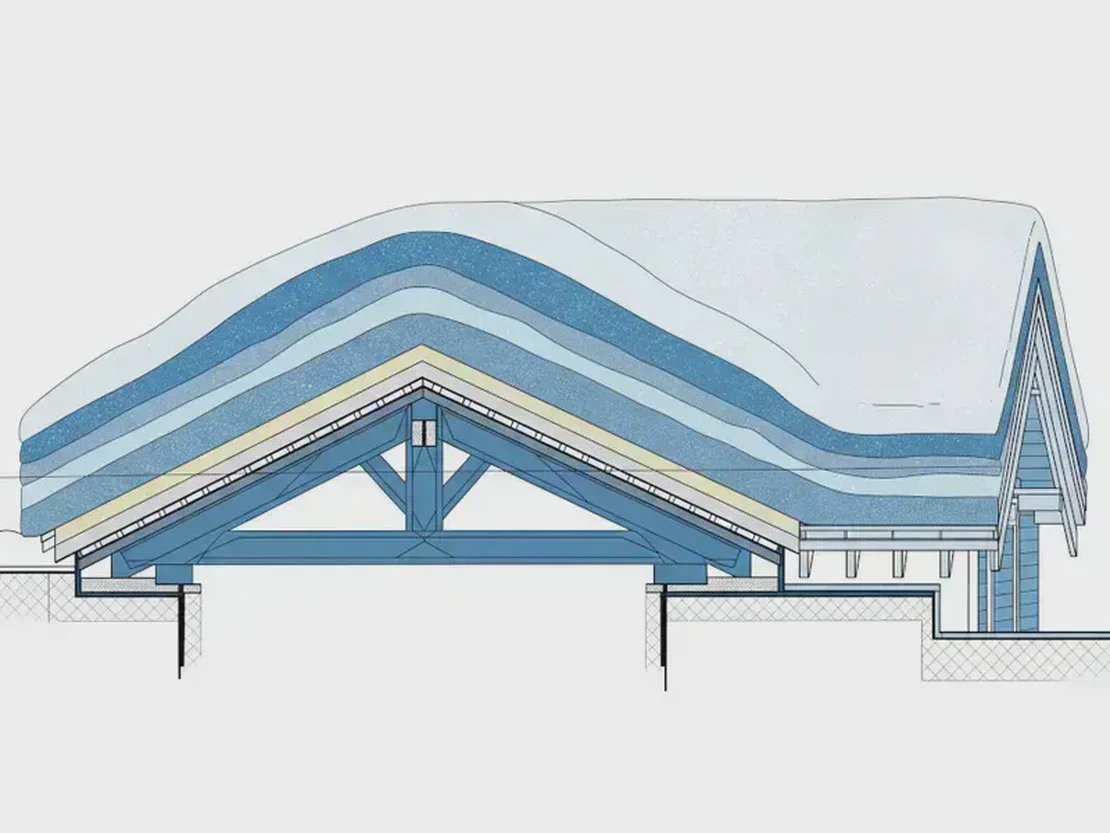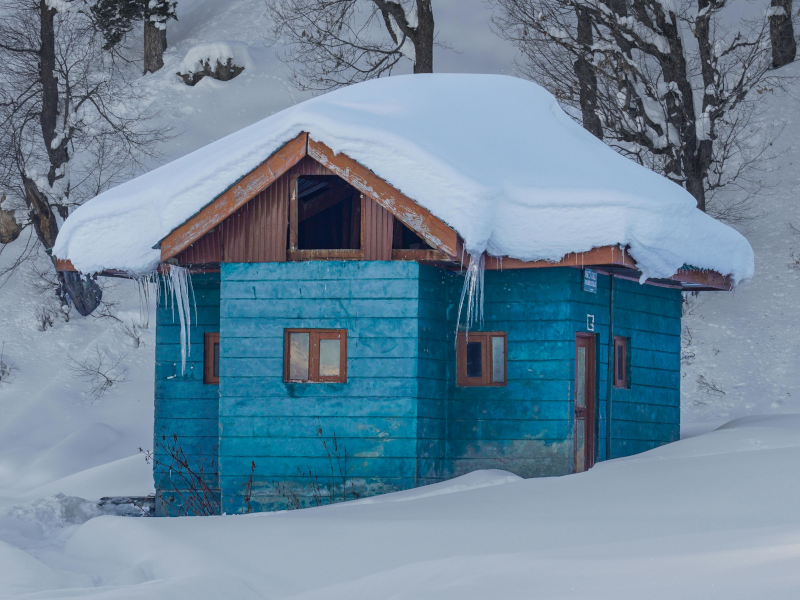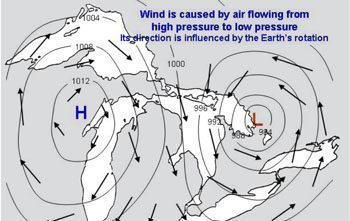A Structural Engineer’s Guide to the Journey of Snow
- Separate Ss vs. Sr and explain how each contributes to the specified roof load— NBCC treats them as paired actions for a reason.
- Use the commentary’s data on snow density evolution to justify why γ and exposure change throughout the season.
- Think geographically: mountains, prairies, and Atlantic storms produce distinct drift behaviours that need tailored detailing.

On this page
The first heavy, wet snow of the season is plastering everything in sight, and you get that familiar call from an architect: “We’re looking at a large, flat roof on this new project. What kind of snow load do we need?”
It’s a question Canadian engineers answer constantly, but the answer is never as simple as just quoting a number from a table. Snow is arguably the most complex and variable load we design for. It’s not a static, uniform material; it’s a dynamic, evolving substance on a climatic and physical journey from the sky to the ground, and eventually, onto our roofs.
To do our jobs right, we need to understand that journey. This article explores some of the core concepts behind the snow load provisions in the National Building Code of Canada (NBCC), leaning on the insights from the code’s commentary: the critical difference between ground snow and its associated rain load, how a fluffy snowflake transforms into a dense, heavy pack, a cross-country tour of Canada’s diverse snow climates, and how our understanding has evolved since the first NBCC.
Decoding the Climatic Data: It’s Not Just Snow (\(S_s\)) but Rain, Too (\(S_r\))
When we start a snow load calculation, our first stop is Appendix C of the NBCC to find our site-specific climatic data. Here, we find two critical values: \(S_s\) and \(S_r\). Junior engineers sometimes overlook the second one, but it’s a crucial part of the equation.
\(S_s\) – The 1-in-50-Year Ground Snow Load: This is our baseline. It’s the load (in kPa) due to snow on the ground that has a 1-in-50 probability of being exceeded in any given year. It’s derived from decades of measured snow depths and densities across the country.
\(S_r\) – The 1-in-50-Year Associated Rain Load: This is the load from rainwater that can fall on and be absorbed by the existing snowpack.
Why do we add a specific rain load? The NBCC Commentary explains that while historical snow surveys account for some moisture, the measurements rarely happen right after a heavy rainfall. Therefore, the base \(S_s\) value doesn’t fully capture the rapid increase in weight when a cool snowpack gets drenched by a winter rain shower. Including \(S_r\) in the specified snow load formula, \(S\), is a direct and rational way to account for this short-term, high-load scenario.
The full formula from NBCC 4.1.6.2 is, of course:
$$S = I_s [S_s (C_b C_w C_s C_a) + S_r]$$This formula acknowledges that the final load on the roof is a combination of the initial snow, modified by various factors, plus the potential for a significant rain-on-snow event. The Importance Factor, \(I_s\), is determined by the building’s use, a topic we cover in detail in our guide to nailing Importance Categories in NBC 2020.
Design reminder: Don’t forget \(S_r\). It represents a real and potentially critical loading event. It’s the reason a moderate snow depth can suddenly become a much heavier problem for a roof structure.
The Metamorphosis of a Snowflake: Understanding Specific Weight (\(\gamma\))
Snow isn’t a single material. Its properties change dramatically from the moment it lands. This transformation, or metamorphism, is key to understanding why we can’t use a single density value for our calculations.
Freshly fallen snow is made of large, complex ice crystals. It’s light and fluffy, with a low specific weight (\(\gamma\)) of about 0.5 to 1.0 kN/m³. But almost immediately, the delicate points of the crystals begin to break down and sublime, causing the snowpack to settle and densify. Even at sub-zero temperatures, the specific weight can quickly increase to 2.0 kN/m³ or more. Over the course of a winter, as it gets compressed by new snow and undergoes freeze-thaw cycles, this value can climb to a dense 5.0 kN/m³.
For calculating drift loads (using factors like \(C_a\)), we need a reasonable estimate of this specific weight. The 2015 NBCC introduced a formula in Article 4.1.6.13 to give designers a consistent basis:
$$ \gamma = 0.43S_s + 2.2 \text{ kN/m}^3, \text{ with a maximum of } 4.0 \text{ kN/m}^3 $$This formula, which was adopted after being found to be consistent with Canada’s climatic reality, cleverly links the specific weight to the ground snow load. The logic is that in regions with higher ground snow loads (\(S_s\)), the snowpack tends to be deeper and more compacted, leading to a higher specific weight. The 4.0 kN/m³ cap exists because values higher than this are exceptionally rare.
A Coast-to-Coast-to-Coast Perspective on Snow
Canada’s vast geography means “snow” has a different meaning depending on where you’re practicing. The NBCC Commentary provides a great overview of these regional personalities.
The Mountains: Heavy Packs and Elevation Effects (B.C. & Alberta)
The mountainous regions of Western Canada see the heaviest snow loads in the country. The snowpack often lasts the entire winter and, most importantly, varies dramatically with elevation. A value for \(S_s\) at the valley floor can be dangerously non-conservative for a structure just a few hundred metres up the mountain. Always confirm the specific elevation for your project site. In some coastal B.C. locations, however, the snow is often so wet and heavy that significant drifting is less of a concern.

The Prairies & The North: It’s All About the Wind
The Prairies and the northern territories have a different challenge. While annual snowfall might be less than in other regions, the combination of very cold temperatures and frequent, strong winds means drifting is the dominant factor. This is where a deep understanding of the accumulation factor, \(C_a\), and the provisions for multi-level roofs and obstructions in NBCC 4.1.6.5 becomes absolutely critical for a safe design. For a more detailed look at these scenarios, our practical guide to snow loads on modern roofs is a great resource.
Central & Atlantic Canada: The Lake-Effect Engine
Ontario, Quebec, and the Atlantic provinces experience a mix of moderate snowfalls and winds. A unique and critical phenomenon here is lake-effect snow. As cold, northwesterly winds pass over the relatively warm, open waters of the Great Lakes or the Gulf of St. Lawrence, they pick up immense amounts of moisture and dump it as intense, localized snow on the leeward shores. This can create pockets of extremely high ground snow loads that must be accounted for in design.

A simple diagram shouding arrows for a typical northwesterly windtrack. Source: greatlakesscuttlebutt.com
A Look Back: The Evolution of Snow Loads in the NBCC
Our current snow load provisions didn’t appear out of thin air. They are the result of over 70 years of research, observation, and refinement, part of the broader evolution of structural design in the NBCC. Understanding this history gives context to why we do things the way we do.
- 1953: The first NBCC was very basic. The design snow load was simply the ground snow load, with some reduction for sloped roofs. This was a blunt instrument that led to both over-design and, more dangerously, under-design, especially for drift-prone roofs.
- 1960s: The game-changer was a massive, country-wide survey of snow on roofs led by the National Research Council. This real-world data provided the basis for the
80%rule in the 1960 code (roof load = 0.8 x ground load). By 1965, this was further refined with coefficients for wind exposure and snow accumulation, marking a shift to a more rational, factor-based approach. - 1990: A milestone year. The code formally separated ground loads into the snow (\(S_s\)) and associated rain (\(S_r\)) components we use today. The specific weight of snow for calculations was also increased to 3.0 kN/m³.
- 2005-2015: The modern era. The probability was increased to 1-in-50 years, and the importance factor (\(I_s\)) was introduced. Critically, a lot of the guidance that was once buried in the Commentary was moved directly into the code, and the formula for calculating specific weight (\(\gamma\)) was introduced in 2015.
This evolution shows a clear path from simple, empirical rules to the sophisticated, risk-based approach we have today, all driven by Canadian research and experience. It mirrors the philosophical shift towards Performance-Based Design that allows engineers to target specific outcomes
Applying This on Real Projects
From a fluffy crystal to a dense, rain-soaked pack, snow is a formidable and fascinating challenge. As engineers, looking beyond the numbers to understand the physical journey of snow allows us to apply the NBCC provisions with greater confidence and intelligence. Recognizing that \(S_r\) accounts for a winter downpour, that \(\gamma\) changes with the climate, and that a roof in Revelstoke faces a different beast than one in Regina is fundamental to sound structural design in Canada.
Think about the most challenging or unusual snow loading condition you’ve had to design for in your practice—those cases are often the best check on how you apply these NBCC provisions.
References
- National Building Code of Canada 2020, Volume 1, Division B, Part 4.
- Structural Commentaries (User’s Guide – NBC 2020: Part 4 of Division B), Commentary G, Snow Loads.
Disclaimer: This blog post is for informational purposes only and should not be taken as specific engineering advice. Always consult the latest edition of the National Building Code of Canada and relevant CSA standards for your projects.
Next up for you
Standards, Design Principles, Practical Applications, Industry Insights
A Practical Guide to NBCC 2020 Snow Loads on Modern Roofs
How NBCC 2020 handles sliding snow, solar panel arrays, and the loads on snow retention systems and sunshades on modern roofs.
Keep reading →Standards, Design Principles, Practical Applications
5 Live Load Nuances in the NBCC Commentary
A deep dive into five often-missed live load provisions in the NBCC 2020 commentary that every Canadian structural engineer should know, …
Keep reading →Standards, Design Principles, Industry Insights, Practical Applications
Part 4's Leap vs. Part 9's Sticking Point
A deep dive into the NBCC 2020 seismic updates, comparing Part 4's evolution with CanadaSHM6 and Part 9's lag, and what it means for your …
Keep reading →Was this helpful?
Tell us what to cover next or request a deeper dive—every response goes straight to Arun.